But I was wrong.
The first indication I got that I might have been a bit over eager was when I received an email from Derek Wilson saying, “ I have a copy of YM #38 and the copyright notice is not in the frame as shown in the Nostalgia - Spotlight on the Fifties book.” Derek Wilson knows a thing or two about Marvelman, having provided an introductory article for TwoMorrow’s recent Marvelman issue of Alter Ego, which is more or less reproduced here on the Crikey! website. After everything I had said about conservative approaches to information and backing up any claims with further research, it seemed that I had all the while been digging my own trap, and blithely walking into it...
So, further research was called for. I needed two things. Firstly, I needed my own copy of Young Marvelman #38. Although the person who wrote to me sent me a photograph of the page in question, I very much felt that I wanted to have empirical first-hand knowledge of everything I had referred to, so went looking for a copy of YM #38 on the internet, and was lucky enough to locate one quite easily. The other thing I wanted to find was another copy of Mick Anglo’s Nostalgia - Spotlight on the Fifties. My original copy of this was not actually the first edition published by Jupiter Books in 1977, but a later edition published by Universal Books in 1985.In the eight years between 1977 and 1985 Marvelman had been revived in Dez Skinn’s seminal Warrior magazine, so I felt it was important to be completely sure of all the dates of the appearances and non-appearances of the copyright notice. Again, I found a copy of this quite easily, so I’m now in a position to address the whole think once again, this time with more accuracy, hopefully, and also with even more pictures.
So, to go back to where I started, Michael Anglo’s Nostalgia - Spotlight on the Fifties - originally published by Jupiter Books in 1977, and republished without any changes by Universal Books in 1985 - contained this page from Young Marvelman #38:
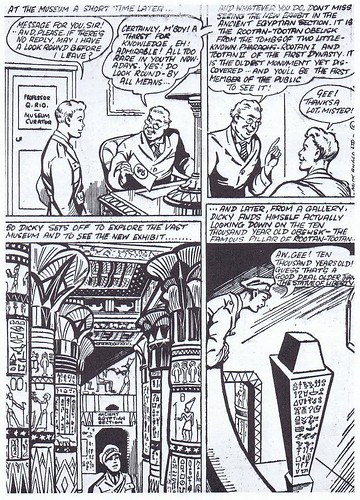
I drew especial attention to the top right-hand panel:
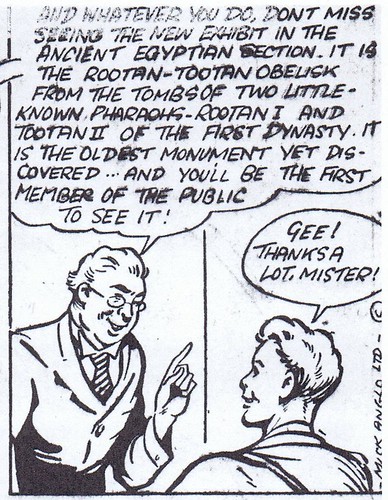
I particularly wanted to highlight the copyright notice written on the right-hand side of the panel:
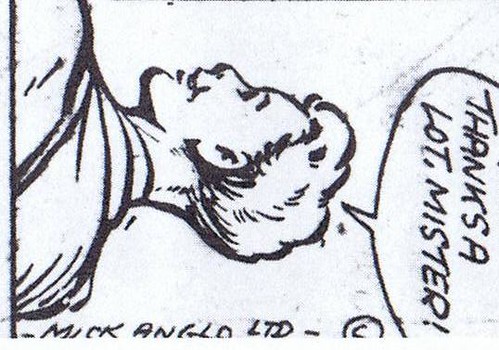
And that was my smoking gun. Except that it wasn’t.
Here’s the cover of my very own recently purchased copy of Young Marvelman #38:
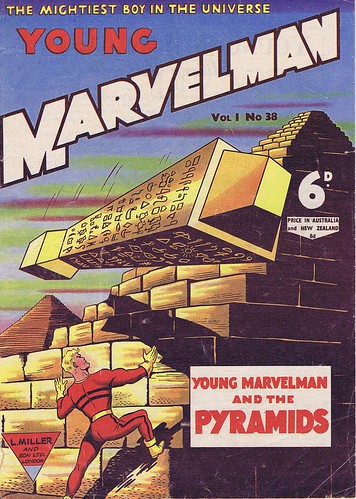
And here’s a scan of page two of that comic:
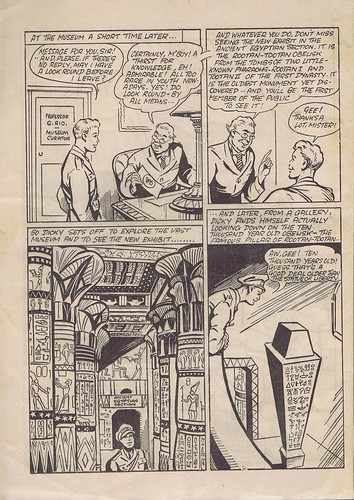
(If you think I’ve been scanning things off centre, by the way, I haven’t. The artwork is really that far askew on the page. But I digress...)
And here’s a scan of the top right-hand panel:
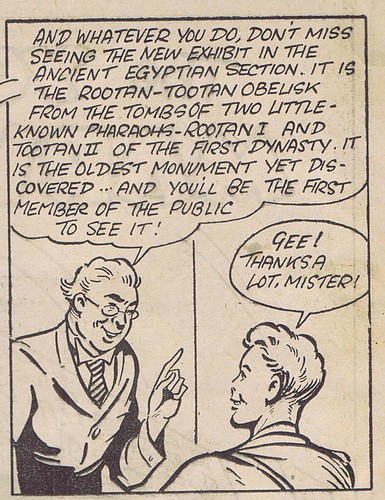
So, no line claiming copyright, and the lack of that line completely undermines my earlier theory that Mick Anglo had attempted to claim at least some sort of ownership of the Marvelman characters very early on. Indeed, the indicia from Young Marvelman #38, which you can see here, states, amongst other things, that “All stories and illustrations are the copyright of the publishers...”
So, where did the notice come from, and why would it have appeared? The first think I wanted to know was, was it Mick Anglo who added the inscription to the page? Here’s the cover of the 1958 Young Marvelman Annual:
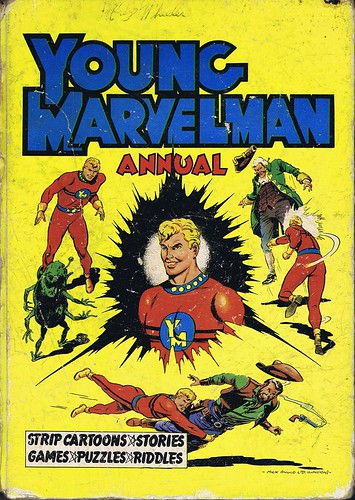
Down in the bottom right-hand corner of this there is a line of handwritten text, which says -Mick Anglo Ltd (London) - , as you can see here:

You can compare this to this signature from the page in Nostalgia - Spotlight on the Fifties:

At the risk of once more going out on a limb, I’m going to say that it’s the same hand doing the lettering in both cases, and I’m also going to suggest that the person doing the lettering is Mick Anglo himself. As far as I know, he did a lot of lettering for the comics produced by Gower Street Studios, and who else would be likely to add a copyright notice to his art after it had been used? So, is there any reason that this notice, appearing in a book in 1977, might have any significance. Well, yes, I rather think there might well be.
In this post on Steve Holland’s excellent Bear Alley, Holland says:
Alan is perfectly correct in saying that the publisher -- Len Miller & Co. (Hackney) Ltd. -- didn't go bankrupt. However, it did go into voluntary liquidation. The decision was made at a meeting of directors on 21 June 1972 and the company was officially wound up on 24 September 1974. From my non-lawyerly perspective, that means that any copyrights held by the company did not go into the hands of a liquidator or trustee in bankruptcy to be sold off as an asset of the company. It was a decision made by the directors (Florrie Miller, Arnold Miller and Doreen Lewis), debts and wages were paid off and the company was shut down. The contents of a warehouse full of old unsold copies of magazines was sold off; a British dealer by the name of Brian Jepson bought a lot of it and others may have tapped into the same source. That's why you can occasionally find mint condition Miller comics, although that's increasingly rare these days.
So where did that leave the copyright of Marvelman? The question that needs answering is: when a company shuts down voluntarily, do the copyrights held by that company remain with that company despite the fact that it no longer exists, or do the rights revert to the original creators, or do they become public domain?
This is why I find the date of the publication of Anglo’s Nostalgia - Spotlight on the Fifties so intriguing. L Miller & Co. Ltd went into liquidation in 1974, and three years later Anglo publishes a page of Young Marvelman artwork from 1954 with a copyright notice added to it. Miller’s copyright was now no longer in effect, as a nonexistent company can’t own anything, so Anglo is the next in line, it would seem, and certainly would have seemed so to himself, I imagine. And the copyright notice appears in the original edition in 1977, as well as in the later edition in 1985, meaning that Anglo was claiming this for himself in 1977, five years before Marvelman’s reappearance in Warrior in 1982, so was not motivated by the desire to capitalise on the character’s success there. It can only be that Mick Anglo wished to reclaim his own creation, even if, as seemed likely at the time, there was no likelihood of it ever reappearing, and the liquidation of L Miller & Co allowed him to, more or less legitimately, do this.
So that’s what I’m putting forward this time: Mick Anglo attaching a copyright notice to old artwork for a 1977 publication is even better proof of his claim on the Marvelman copyright that if the same copyright notice had originally appeared in 1954. I will have more to say on all of this at a later point...*
(*In the original article I also alluded to the fact that all of this springs out of research for what might become a book. This is something I can now confirm. In the summer of 2011 MonkeyBrain Books will publish what I’m provisionally calling Poisoned Chalice: The Extremely Long and Incredibly Complex Story of Marvelman. I am, to say the very least, extremely excited about this, and much of 2010 is going to be spend immersed in research for the book, as well as actually writing it. I’m already about ten thousand words into it, and I’ve absolutely no idea how long it’s going to be in the end, but long it certainly will be. It’s entirely possible that there’ll be more posts here of sidebar issues arising out of that research, though. But this post is probably the last one that will deal directly with material from the book itself.)

Excellent research... and look forward to your Marvelman book in 2011!
ReplyDelete...So, in other words, this is a case where the Smoking Gun had the serial numbers filed *on*?
ReplyDeleteAny chance that the the copyright was on the original art and removed by Miller before publication?
ReplyDeleteNah, I doubt it. If nothing else, the scan in Anglo's book is a lot dirtier than the art in the original comic, leading me to suspect that's it's a later generation copy than the one in the comic.
ReplyDelete